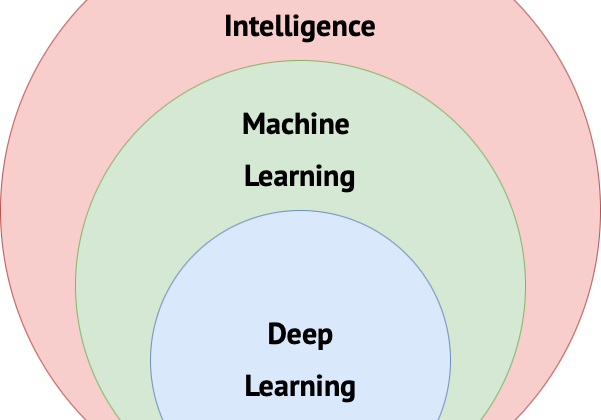
We’re going to explain what Artificial Intelligence, Machine Learning and Deep learning are and the differences between them as many people get them mixed up and use the wrong one.
As you can see in the diagram, Artificial Intelligence (AI) contains both Machine Learning (ML) and Deep Learning (DL). Machine Learning is a part of Artificial Intelligence and Deep Learning is a part of Machine Learning.
Broadly speaking, it’s a system or machine that simulates the intelligence of humans to do specific tasks and that can iteratively improve themselves (get better as time goes on). Examples of Artificial Intelligence can range from facial recognition, robot vacuums (like the Roomba) and chatbots.
A system that automatically learns and improves with experience without explicitly writing code for it. For example, you could train a system to predict what type of fruit is in a photo. The system will learn different rules including a pear is green, an apple and an orange are round, etc. There are two types of Machine Learning, Supervised and Unsupervised Learning.
Supervised Learning is learning when the data set consists of inputs and outputs and is generally used to predict things. The outputs are what you want to predict and the inputs are what you use to predict the output. The example above, which predicts the type of fruit in an image, is an example of Supervised Learning, the image is the input and the type of fruit is the output.
Unsupervised Learning is learning when the data set does not have outputs. Therefore, it only has inputs. Normally this type of learning is used to
- Find patterns in a dataset, for example, to predict which items are regularly bought together in an e-commerce website.
- Put entries in a dataset into groups, for example, to group similar customers of a product together.
Deep Learning is a type of Machine Learning which uses a specific type of algorithms that are called Neural Networks. The concept of Neural Networks comes from how the human brain works, where neurons are interconnected. Generally, you would need a big dataset to train Deep Learning models. Examples include face recognition, text generation and image classification.
Neuron
A neuron has many inputs and one output. The neuron takes in the inputs (X1, X2, …, Xn) and performs some arithmetic after which it will return the output y.
Neural Network
Think of a neural network as a complex function, it has its inputs (X1, X2, …, Xn) and it has its outputs (y1, …, ym). When the neural network is learning, it learns how to predict its output from its inputs. If you look at it as a function, it is learning the equation of the function. A neural network has an input layer (green), one or more hidden layers (blue) and an output layer (Red).
For example, a neural network has three inputs and two outputs. The inputs, (X1, X2, X3), are the dimensions of a cuboid. The output y1 is the volume of the cuboid and y2 is its surface area. The hidden layer performs the necessary arithmetic to produce its output, like a function.
That’s it!
Thank you for reading the article, this is my first one so I would love some feedback! If you find any mistakes in the article please reach out to me and I’ll happily make the change. Follow me on Twitter for more tech related content and tweet the article!
